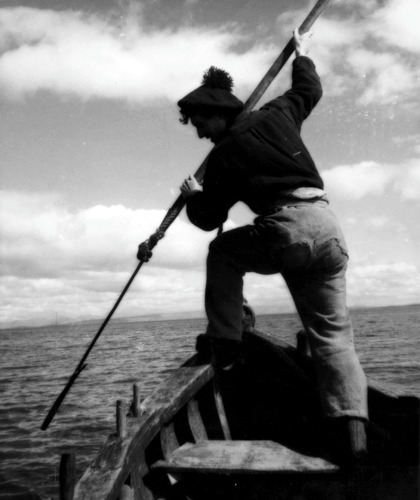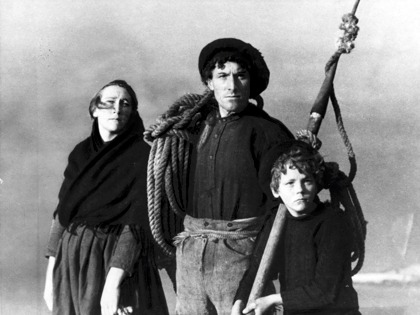Review / From the archives
Man of Aran

Robert Flaherty’s idyllic epic of Irish island fishermen is a triumph of ‘living cinema’, wrote Paul Rotha in our original 1934 review
Man of Aran
UK 1934
Director: Robert J. Flaherty
Documentary.
103 mins | Cert PG
Hope has been built upon hope around this picture of Flaherty’s, for at last here was the father of documentary with an honest break to do something big in a manner after his own heart. Two long years in the making, month after month of waiting by we poor folk who knock out a humble living at backdoor documentary, and the film is here to give us more or less of what we expected and something else beyond. In all respects it is the best work that Flaherty has done in cinema and in its particular sphere represents the furthest lengths to which documentary of this sort has been taken. But I would lay emphasis on category, for Man of Aran pursues only one of the several paths of documentary and must be considered only within those limits.
There are moments in the film which are among the greatest things that cinema can show, which means at the least that they provide both a mental and a physical experience which is unforgettable. There are moments when the instinctive caressing of the camera over the movements of a boy fishing or of men against the horizon brings a flutter to your senses; so beautiful in feeling and so perfect in realisation that their image is indelible. And again there are softer passages where you have to collect your thoughts and wonder if the sequence construction is built up quite so firmly as documentary of any branch demands; and whether dawdling over a woman carrying wet seaweed across the shore, beautiful in itself to behold, does not tend to weaken the main shape of the picture. It might be that two minds have disagreed, each seeking the major issue of the theme and each finding a different answer. Either the dramatic grandeur of the sea or the thrill of the sharks must take precedence, but they disturbingly share the peak between them. So great is Flaherty’s shooting of the sea, nothing like it has ever been seen on the screen and so overwhelming the sweep of the Atlantic that the sharks, I feel, are commonplace. It is true that they spell box-office to the commercial mind, but in such a film as this such considerations should be superfluous.
Beyond this small point, raised only because of the film’s stature, Man of Aran is unique for its quality of visual loveliness. Seldom have such superb scenes lightened the movie screen, and only in previous Flaherty pictures have we seen that anticipation and awareness of natural movement which is Flaherty’s particular genius. Here and there were scenes which I could watch a dozen times, lingering over the selection of camera set-ups and admiring the smooth grace of the camera’s action. Flaherty can give us a boy casting a line, a man repairing his boat or a stone being split into fragments more superbly than any other director, but his relation of these to the wider theme is a matter open to discussion.

The absence of any artificial narrative is a final justification of the documentary approach to cinema. Here is the living scene as it appeared to Flaherty recreated in terms of living cinema. Its complete success serves to show up the humbug of those epics of the Frozen North and Hot Africa to which we have so often been subjected. In the control of his human material, Flaherty has shown us the value of restraint. His approach is wholly impersonal. What really happens on Aranmore is not his or our concern in this conception. At no moment is there ‘acting’ in the sense that the word is customarily used. His characters are normal persons doing things which are normal to them. But because of Flaherty’s approach this normality has been transmuted into an idyllic work.
Descending to technical details, Goldman has made a solid job of the editing under Flaherty’s supervision and [John] Greenwood has written some quite good music which is not well recorded. The dialogue, some of which is in Gaelic, I found unnecessary but not disturbing. Special mention should be made of John Taylor, a recruit from the Empire Market Board Unit, who assisted Flaherty throughout the production.
As this appears, Man of Aran will be in the cinemas and it remains to be seen what the people will make of it. So far all concerned in its birth and growth, from producing firm to laboratory worker, deserve congratulation; and this does not exclude the publicity which has accompanied the production and exhibition of the film. Its fate, and incidentally that of much unborn documentary, will lie in the purses of the public.
Paul Rotha, Sight & Sound, Summer 1934
‘Man of Aran’ is out now on DVD from Park Circus
See also
This is our land: liminal Britain at the London Short Film Festival: Frances Morgan on film collective Kino London’s Borderlands DIY project (January 2011)
Ah, Liberty!: Kieron Corless on Ben Rivers’ experimental portraits of the British hinterlands (November 2008)
Love Letters and Live Wires: Highlights from the GPO Film Unit reviewed by Michael Brooke (November 2008)
Documentary: shaking the world: Mark Cousins on documentaries that affected history (September 2007)
